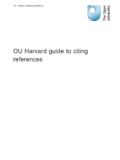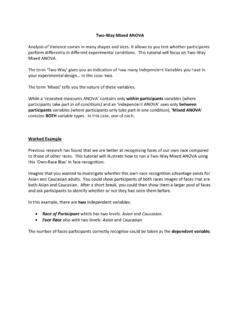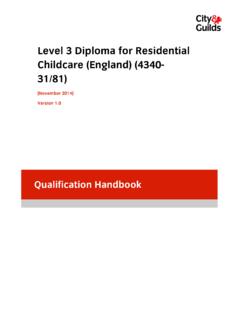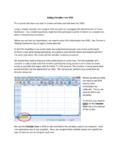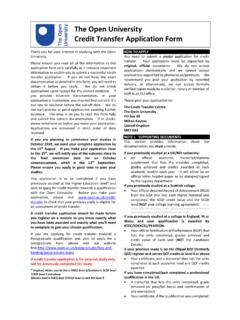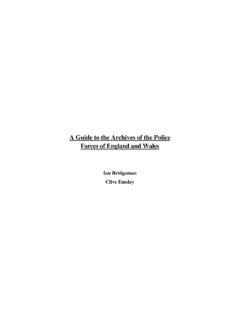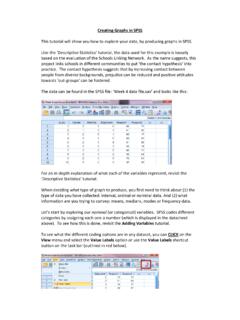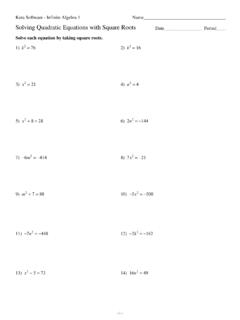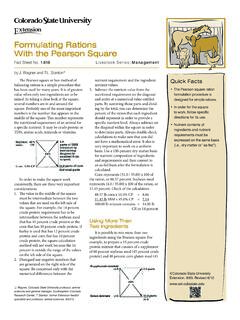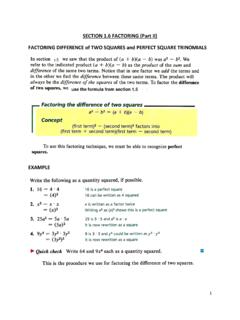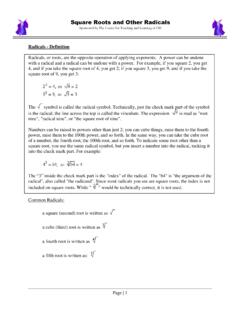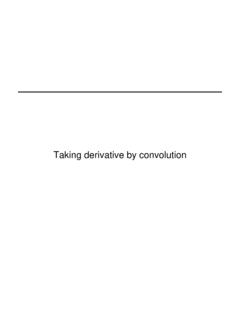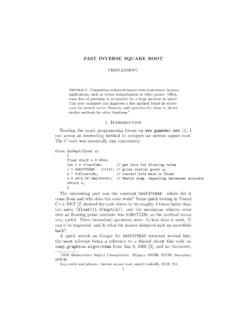Transcription of Chi Square Analysis - Open University
1 Chi Square Analysis When do we use chi Square ? More often than not in psychological research, we find ourselves collecting scores from participants. These data are usually continuous measures, and might be scores on a questionnaire or psychological scale, reaction time data or memory scores, for example. And when we have this kind of data, we will usually use it to look for mean differences on scores between or within groups ( using t-tests or ANOVAs), or perhaps to look for relationships between different types of scores that we have collected ( correlation, regression). However sometimes we do not have this kind of data. Sometimes data will be a lot simpler than this, instead consisting only of frequency data.
2 In these cases participants do not contribute scores for Analysis ; instead they each contribute to a head count within different grouping categories. This kind of data is known as categorical data, examples of which could be gender (male or female) or University degree classifications (1, 2:1, 2:2, 3, pass or fail) or any other variable where each participant falls into one category. When the data we want to analyse is like this, a chi- Square test, denoted , is usually the appropriate test to use. What does a chi- Square test do? Chi- Square is used to test hypotheses about the distribution of observations in different categories. The null hypothesis (Ho) is that the observed frequencies are the same as the expected frequencies (except for chance variation).
3 If the observed and expected frequencies are the same, then = 0. If the frequencies you observe are different from expected frequencies, the value of goes up. The larger the value of , the more likely it is that the distributions are significantly different..but what does this mean in English? To try and explain this a little better, let's think about a concrete example. Imagine that you were interested in the relationship between road traffic accidents and the age of the driver. We could randomly obtain records of 60 accidents from police archives, and see how many of the drivers fell into each of the following age-categories: 17-20, 21-30, 31-40, 41-50, 51-60 and over 60. If there is no relationship between accident-rate and age, then the drivers should be equally spread across the different age-bands ( there should be similar numbers of drivers in each category).
4 This would be the null hypothesis. However, if younger drivers are more likely to have accidents, then there would be a large number of accidents in the younger age-categories and a low number of accidents in the older age-categories. say we actually collected this data, and found that out of 60 accidents, there were 25 individuals aged 17-20, 15 drivers aged 21-30 and 5 cases in each of the other age groups. This data would now make up our set of observed frequencies. We might now ask: are these observed frequencies similar to what we might expect to find by chance, or is there some non-random pattern to them? In this particular case, from just looking at the frequencies it seems fairly obvious that a larger proportion of the accidents involved younger drivers.
5 However, the question of whether this distribution could have just occurred by chance is yet to be answered. The Chi- Square test helps us to decide this by comparing our observed frequencies to the frequencies that we might expect to obtain purely by chance. It is important to note at this point, that that Chi Square is a very versatile statistic that crops up in lots of different circumstances. However, for the purposes of this handout we will only concentrate on two applications of it: Chi- Square "Goodness of Fit" test: This is used when you have categorical data for one independent variable, and you want to see whether the distribution of your data is similar or different to that expected ( you want to compare the observed distribution of the categories to a theoretical expected distribution).
6 Chi- Square Test of Association between two variables: This is appropriate to use when you have categorical data for two independent variables, and you want to see if there is an association between them. Chi- Square "Goodness of Fit" test This is used when you have one independent variable, and you want to compare an observed frequency-distribution to a theoretical expected frequency-distribution. For the example described above, there is a single independent variable (in this example age group ) with a number of different levels (17-20, 21-30, 31-40, 41-50, 51-60 and over 60). The statistical question is: do the frequencies you actually observe differ from the expected frequencies by more than chance alone?
7 In this case, we want to know whether or not our observed frequencies of traffic accidents occur equally frequently for the different ages groups (so that our theoretical frequency-distribution contains the same number of individuals in each of the age bands). The way in which we would collate this data would be to use a contingency table, containing both the observed and expected frequency information. Age band 17-20 21-30 31-40 41-50 51-60 over 60 Total: Observed frequency of accidents 25 15 5 5 5 5 60 Expected frequency of accidents 10 10 10 10 10 10 60 To work out whether these two distributions are significantly different from one another, we use the following Chi- Square formula: This translates into: (observed frequency expected frequency)2 2 = sum of ( , across categories) (divided by) expected frequency This may look complicated, but really it just means that you have to follow four simple steps, which are described on the next page.
8 Step One Take each observed frequency and subtract from it its associated expected frequency ( , work out (O-E) ): 25-10 = 15 15-10 = 5 5-10 = -5 5-10 = -5 5-10 = -5 5-10 = -5 Step Two Square each value obtained in step 1 ( , work out (O-E)2): 225 25 25 25 25 25 Step Three Divide each of the values obtained in step 2, by its associated expected frequency ( , work out (O-E)2): E 225 = 25 = 25 = 25 = 25 = 25 = 10 10 10 10 10 10 Step Four Add together all of the values obtained in step 3, to get your value of Chi- Square : 2 = + + + + + = 35 Assessing the size of our obtained Chi- Square value: What you do, in a (a) Work out how many "degrees of freedom" ( ) you have.
9 (b) Decide on a probability level. (c) Find a table of "critical Chi- Square values" (in most statistics textbooks). (d) Establish the critical Chi- Square value for this particular test, and compare to your obtained value. If your obtained Chi- Square value is bigger than the one in the table, then you conclude that your obtained Chi- Square value is too large to have arisen by chance; it is more likely to stem from the fact that there were real differences between the observed and expected frequencies. In other words, contrary to our null hypothesis, the categories did not occur with similar frequencies. If, on the other hand, your obtained Chi- Square value is smaller than the one in the table, you conclude that there is no reason to think that the observed pattern of frequencies is not due simply to chance ( , we retain our initial assumption that the discrepancies between the observed and expected frequencies are due merely to random sampling variation, and hence we have no reason to believe that the categories did not occur with equal frequency).
10 For our worked (a) First we work out our degrees of freedom. For the Goodness of Fit test, this is simply the number of categories minus one. As we have six categories, there are 6-1 = 5 degrees of freedom. (b) Next we establish the probability level. In psychology, we use p < as standard and this is represented by the 5% column. (c) We now need to consult a table of "critical values of Chi- Square ". Here's an excerpt from a typical table: (d) The values in each column are "critical" values of Chi- Square . These values would be expected to occur by chance with the probability shown at the top of the column. The relevant value for this test is found at the intersection of the appropriate row and probability column.
